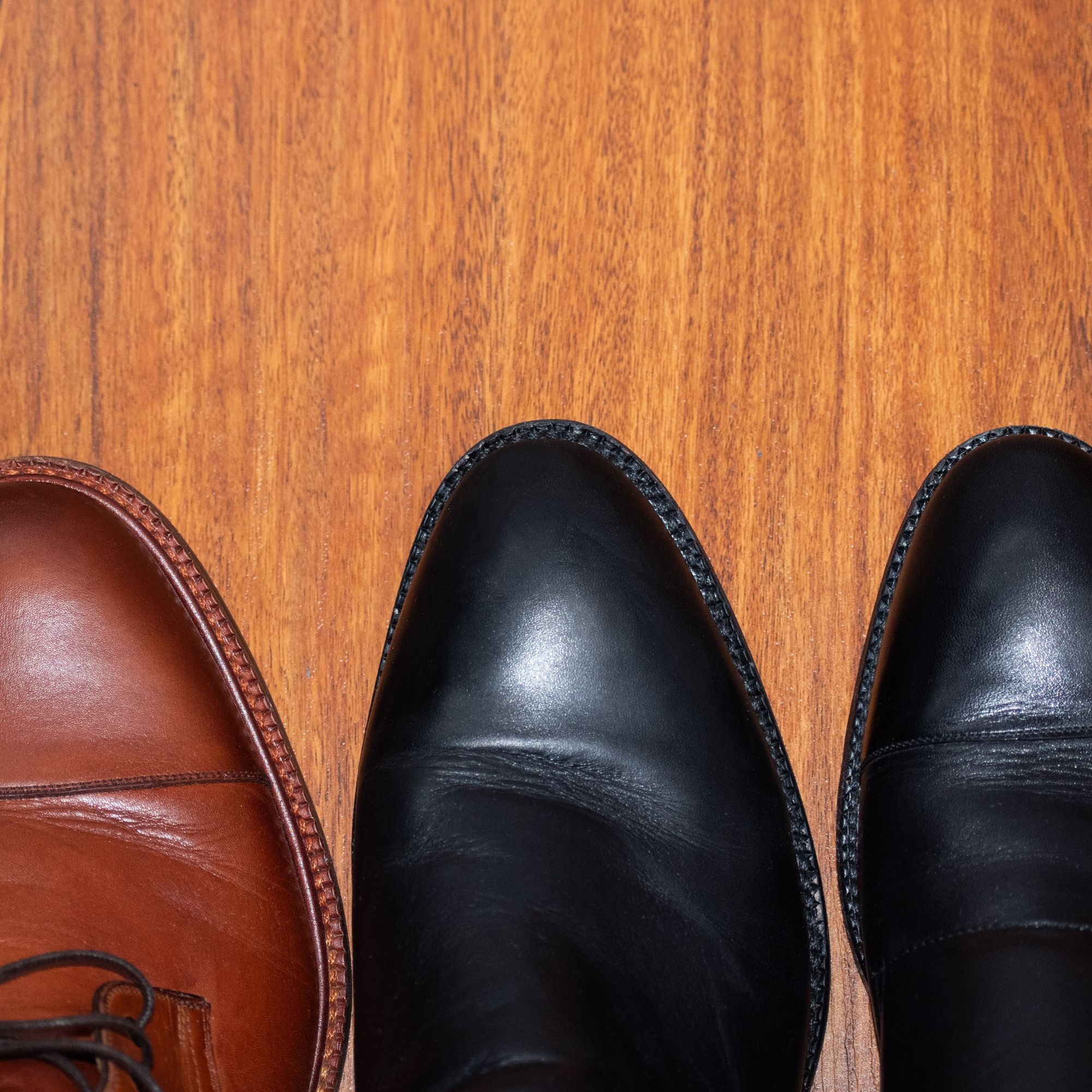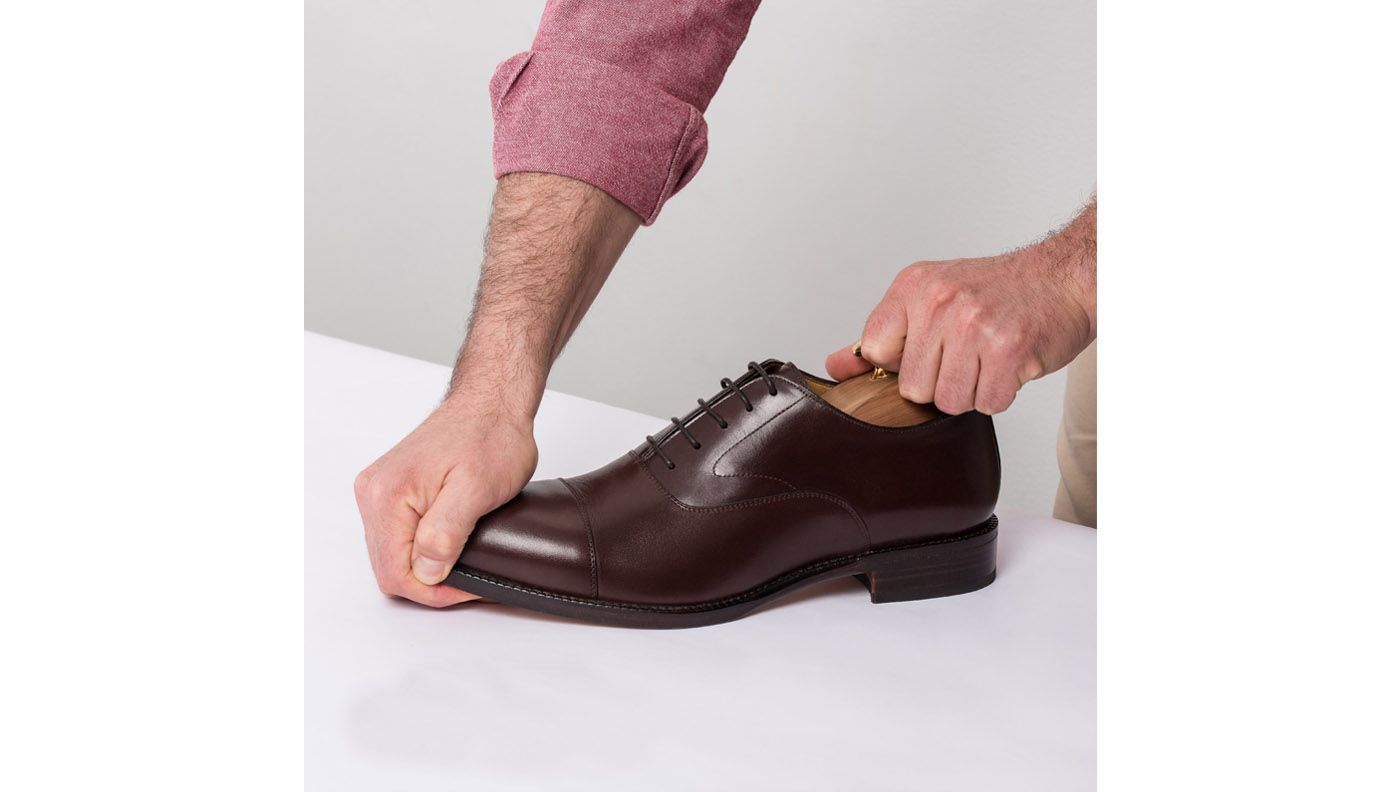
Is Leather Shoe Creasing Normal?
Written by Tigre HallerWhat Causes Leather Shoes To Crease?
Leather creases, it’s just a fact of life. And a fact of wearing fine leather shoes. Really, there’s nothing to worry about, but you should understand what causes creasing to your shoes, and how to deal with it.
First, creasing isn’t related to the quality of the leather. Being a natural material, leather is supple, flexible and becomes more malleable the more you wear it. Part of the joy and pleasure of wearing full-grain leather shoes is how they conform to the shape of your foot over time. And your foot is key. Just like every shoe we make is unique, so is every wearer. There’s literally no “one size fits all” as each shoe will fit each foot differently.
For example, my feet slope from my insteps down to my toes. So, I know my shoes will develop a deep crease in that area of the upper. Without fail it always happens. It used to bother me until I realized it’s all part of my shoe-wearing experience. And, what makes my shoes unique to me.
When your feet bend while walking or crouching, creasing will inevitably happen. If your shoes don’t bend, they will be extremely uncomfortable.
Many other factors contribute to shoe creasing, such as:
The way that you walk, or your “gait” will have an impact. For example, if your foot rolls to the side when you walk you could also be twisting the leather. Or, if you tend to roll from the ball of your feet to your toes, you will put more stress on the leather. Some people drag their feet which can cause all sorts of damage to their shoes, including creases.
If the shoe’s toe box is too flat, your toes have to work more to push your foot off of the ground. This makes your toes bend more and leads to more creasing. (The degree at which the shoe’s toe box elevates above the ground is called "toe spring.")
Shoes that are too big have excess room between the foot and the upper, which makes it difficult for the foot to hold the shoe’s shape properly.
Excess moisture can also lead to creasing, especially if it sits on or in your shoes for too long.
Design and model plays a big part in shoe creasing. Wholecut shoes, which are made with one piece of leather, tend to be prone to more creasing than a heavily ornamented style like a full-brogued wingtip. It makes sense since the former style is created with several pieces that reinforce the upper, and the latter is like a pristine blank canvas.
The longer the upper takes shape on the last (the foot-shaped mold), the better. The leather needs enough time to settle, and solidify the shape. We allow our shoes to adapt on the lasts for at least 72 hours; wholecuts are lasted for 120 hours, which is longer than industry standards.
How To Prevent Shoes From Excessive Creasing
Don’t be discouraged by the reasons discussed above. Remember, high-quality full-grain leather shoes are a joy to own and wear - and will last a lifetime with proper treatment.
One of the best things you can do for your shoes is to help prevent creasing as much as possible by following these guidelines:
- Keep away excess moisture by treating your shoes with a waterproofing spray before wearing them. Not only will this help to keep the water off, it should also guard against stains and marks. If you get caught in a downpour or heavy snow, stuffing your shoes with newspapers is an amazing effective way to absorb the moisture.
- Use cedar shoe trees after every wear to wick away moisture from sweat and to help keep the shoe’s natural shape.
- Wear the correct size. Your shoes should hug your feet, with enough room for them to breathe but no gaps.
- Observe how you walk, bend and crouch. If you are putting too much pressure on the sides of your feet or on your toes you might want to consult a podiatrist. If you tend to roll your feet forward when bending or crouching (like I do), then try to keep your feet flat on the ground.
- Check the toe spring which should be at around a 15 degree angle. Ideally you should be able to slide a no. 2 pencil or a pen easily into the space between the toe box and the ground.
- Treat well - use high-quality shoe creams, conditioners, recolorant, and sealant (more on this topic below).
How To Remove Creases From Leather Shoes
Getting creases out of your leather shoes is actually not as challenging as you might think. With some patience and understanding, taking care of this issue shouldn’t present much of a challenge:
- Always insert cedar shoe trees after every wear. Not only will they absorb excess moisture and sweat, they keep the leather stretched and help maintain the shoe’s shape.
- Heat an iron to between 60 and 80 degrees Fahrenheit. Then lay a damp - not sopping wet - folded cotton cloth over the crease. Slowly pass the hot iron over the towel, pressing gently. The hot moisture will soften the leather and help the creases even out. Be sure to check the crease after each pass of the iron for progress and to make sure there’s no damage. It’s also a good idea to stuff your shoes with a lot of newspaper, or some cardboard so they will keep their shape during this process. After the ironing is done, replace the newspaper with a shoe tree, or keep it in if you don’t have one.
- Safely using a blow dryer can be effective in getting creases out. But, you have to be extremely careful and aware of the amount of heat that’s being directed to your shoes. First, bolster the shoe’s shape with either newspapers or a shoe tree. Then turn the blow dryer to the hottest setting possible, hold it at least 3 to 6 inches away from the shoe, and direct the air to the creases. Keep moving the blow dryer from side-to-side to avoid burning while massaging the creased areas. After the creases have stretched out, and your shoes have cooled off, treat them with a high-quality leather conditioner. Be aware though that too much heat can darken the leather and potentially warp the toe and heel. It can also dry the leather out.
- Spray a solution if rubbing alcohol diluted in water directly onto the crease and rub it into the leather. After it has dried, revive your shoes with a high-quality shoe cream or a leather conditioner. Then insert a cedar shoe tree into the shoes to keep them stretched. The negative of this method is that alcohol can dry the leather out, so you really need to keep it moisturized.
- Apply leather conditioner or oil to the entire shoe, not just the creased areas. This will help maintain a uniform appearance. Rub the creased areas with your fingers to help soften the leather. You can do this with a shoe tree already in the shoe, or insert it later to keep the leather stretched.
When To Worry About Loose Grain
Loose grain occurs when the upper and lower grain separate from the tissue of the hide and create thick vein-like wrinkles. Most of the time loose grain will manifest where the shoe flexes the most.
You should worry about loose grain if:
- Your shoes hurt
- Your shoes flex diagonally instead of horizontally (which can happen if the shoe is too big)
- The leather is peeling off
Loose grain can occur even in the highest-quality leather. However, the manufacturer can avoid it if they cut key pieces (the ones that are flexed, like the vamp) from the center of the hide, where the fiber density is higher. But, it can even develop after the shoe is made.
Basic Leather Care Routine
Caring for full-grain leather is relatively straightforward and uncomplicated. However, regular cleaning and maintenance is necessary to keep the pores clear and unclogged.
At the most basic level, you can clean off surface dirt with a soft-bristle brush or a cloth. You can remove light scuff marks and some stains with a solution of diluted soapy water and a clean cloth, then blot it dry with a separate cloth. Then, let the leather air dry.
Always make sure your full-grain garments are completely dry before storing them in an area free of humidity and mold.
Stay away from harsh cleaners and saddle soap. Instead you’ll want to use a high-end leather cream and conditioners to maintain the integrity of your items, and extend the longevity. Then use a cloth and / or soft-bristle brush to buff the leather up to the desired shine.
For shoes, you should always use cedar shoe trees after every use. They help to maintain the shape of your shoes, absorb moisture and impart a pleasant scent.
You can read more about caring for your full-grain leather items here.
Conclusion
Hopefully these tips and methods have helped you to understand that creasing in fine leather shoes is absolutely normal and expected. By following the advice given, you should be able to enjoy your shoes for many years to come.
We would love to hear how you deal with shoe creasing. Just send us a comment below.



Leave a comment
Please note, comments must be approved before they are published.